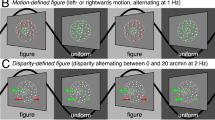Abstract
Autistic, blind, deaf (10 in each handicapped group) and 20 normal children are compared in two experiments focused on responses to stimuli in situations allowing for alternative strategies and coding processes. The autistic (ranging in age from 6 to 14 years) and control groups were matched for levels of cognitive development or for task performance relevant to the functions tested. Like the normal and unlike the blind or blindfolded, autistic children used visual rather than tactile cues to locate stimuli. On the other hand, like the deaf, but unlike the hearing, they organized visually presented verbal items in a spatial rather than temporal ordered sequence. It is suggested that autistic children do not necessarily process visual stimuli inadquately. Rather, processing capacity seems to depend on the availability of codes for organization, which may be relatively independent of the modality in which stimuli are presented.
Similar content being viewed by others
References
Attneave, F., & Benson, D. Spatial coding of tactual stimulation.Journal of Experimental Psychology, 1969,81, 216–222.
Goldfarb, W. Receptor preferences in schizophrenic children.Archives of Neurology and Psychiatry, 1956,76, 643–652.
Hermelin, B., & O'Connor, N. Spatial coding in normal, autistic and blind children.Perceptual and Motor Skills, 1971,33, 127–132.
Hirsh, I. J. Information processing in input channels for speech and language: The significance of serial order of stimuli. In F. L. Darley (Ed.),Brain mechanisms, underlying speech and language. New York: Grune & Stratton, 1967.
Murdock, B. B. Where or when? Modality effects as a function of temporal-spatial distribution of information.Journal of Verbal Learning and Verbal Behavior, 1969,8, 378–383.
O'Connor, N., & Hermelin, B. Spatial or temporal organization in memory?Quarterly Journal of Experimental Psychology, 1972, in press.
Rutter, M. Concepts of autism: A review of research.Journal of Child Psychology and Psychiatry, 1968,9, 1–25.
Schneider, G. E. Contrasting visiomotor functions of tectum and cortex in the golden hamster.Psychologische Forschung, 1967,31, 52–62.
Schopler, E. Visual versus tactile receptor preferences in normal and schizophrenic children.Journal of Abnormal Psychology, 1966,71, 108–114.
Williams, M.Williams test for children with defective vision. Birmingham, England: University of Birmingham, 1957.
Author information
Authors and Affiliations
Rights and permissions
About this article
Cite this article
Hermelin, B. Locating events in space and time: Experiments with autistic, blind, and deaf children. J Autism Dev Disord 2, 288–298 (1972). https://doi.org/10.1007/BF01537619
Issue Date:
DOI: https://doi.org/10.1007/BF01537619




